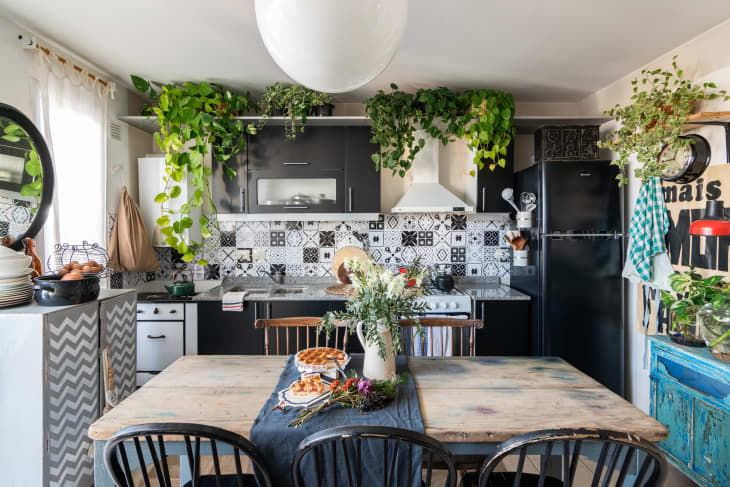5 Things to Keep in Mind When Adding Plants to Your Kitchen Design
Previously, the kitchen was pretty much a functional room built for cooking and storing food. But now this central area has been elevated into a living space that also reflects residents’ personalities and tastes (gastronomic and aesthetic). And with the popularity of biophilic design, based on the idea that humans need a connection to nature indoors to be happy and healthy, plants are turning up in the kitchen like never before.
“Plants create some life in the room and bring in a natural element that every room needs,” says interior designer Veronica Solomon of Casa Vilora Interiors.
So, should you put a philodendron atop your open shelving? What about a Silver Satin vine alongside the sink? We reached out to plant-loving designers and influencers with green thumbs for some tips and suggestions on how to create a plant-filled kitchen of your own.
A quick heads-up: Note that any specific plants mentioned in this story or any others may be toxic to pets or humans. “Toxic” plants can induce symptoms that range from mild (upset stomach) to severe (possible death). If you have a cat, dog, or kid, make sure you research the plants ahead of time on a reputable site like ASPCA.org, PetPoisonHelpline.org, Poison.org, or by calling your vet or pediatrician.
Be strategic about placement.
Cyril Sontanillo Davis, a botanical stylist known as Cyrilcybernated on Instagram and his DIY YouTube channel, says most people fall into one of two camps when it comes to plant care: overwaterers and underwaterers. Figure out which one you are, and then place your kitchen plants strategically to keep them alive.
For example, Davis knows he, and most other plant fans, tend to overwater, so he puts his philodendron up high where he can’t reach it without standing on a chair. (On top of your cabinets would be a good bet here.) That way, he only waters it once a week or so. If you have a plant that tends to droop often, place it closer to the sink so you remember to give it a drink. Of course, make sure you keep your delicate plants away from the stove to spare them from the heat.
Not sure yet which watering category you fall into? The peace lily (Spathiphyllum) is a super forgiving plant that can tolerate being overwatered and underwatered, and it can take both brighter and lower light conditions. Other forgiving plants include the ZZ plant (Zamioculcas zamiifolia) and snake plant (Sansevieria trifasciata).
Figure out your kitchen’s light zones.
If you love gardening, you’ve probably seen the plant hardiness zone map that divides the U.S. into different areas so you know what plants will thrive in yours. Well, J’Maica Thomas, who co-owns BLK Girls Green House in Oakland with friend Kalu Gebreyohannes, says your kitchen has lighting zones, and you need to choose the plant that will prosper in each one.
Have indirect light? Thomas is a big fan of African violets (Saintpaulia), old-school plants your grandma probably grew that are seeing a resurgence. To bloom, violets do best in bright indirect light from a northern or eastern exposure, and too much light will scorch the fuzzy leaves. Have bright light? Snake plants can thrive in the brightest — but they can take lower light if that’s all you’ve got.
Know that humidity isn’t always a good thing.
Pam Gant moved into a house with primo kitchen light: a southern exposure skylight and western exposure windows. So she bought one plant to see how it did. Now, they’ve taken over: She has plants perched on open shelving, sitting on windowsills, and hanging from a beam that traverses the kitchen. “They’re basically everywhere,” says the data analyst who’s co-founder of the Tacoma Houseplant Club, a Facebook group with the motto, “Making friends, growing jungles.”
But one type of plant you won’t find in Gant’s kitchen? Succulents. Because while your orchid might enjoy humidity and mist, those things are not good for all your plants. “I would steam vegetables and it would melt my succulents. It was too much humidity,” Gant says.
Going for the “more plants is more” look? Opt for low-maintenance plants.
In her cozy Yorkshire, United Kingdom, kitchen, lifestyle and plant influencer Pandora Maxton has a central rack filled with greenery suspended over her family’s dining table, plus open shelves where vining plants trail. “I don’t like corners and edges,” says Maxton. “By placing plants along open shelving and at the ends, it softens the overall look.”
She keeps her kitchen looking like a greenhouse by choosing hardy plants that thrive under almost any conditions. Her top plants for trailing over shelf fronts include spider plants (Chlorophytum comosum) because they multiply and they’re almost impossible to kill, climbing philodendrons (Philodendron hederaceum), climbing Devil’s Ivy aka Golden Pothos (Epipremnum aureum), and string of pearls (Senecio rowleyanus), as long as you don’t overwater.
Choose a plant that’s pretty — and practical.
“In the kitchen I love to bring in herbs where it’s actually functional and you use it for cooking or making a cup of tea,” says Solomon, who is based in Katy, Texas, near Houston. If it’s a plant you actually incorporate into your cooking, there’s a bigger chance you’ll nurture it.
In her kitchen, Solomon has rosemary (Salvia rosmarinus) and a little tomato plant situated in spots where they get some bright natural light. She can’t wait to whip up some homegrown pasta sauce. She also recommends incorporating easy-to-grow, bright light-loving chives (Allium schoenoprasum) into your kitchen; you’ll love the way a snip of fresh chives classes up your scrambled eggs.
Apartment Therapy’s Styling with Plants vertical was written and edited independently by the Apartment Therapy editorial team and generously underwritten by Greendigs.
This post originally appeared on Apartment Therapy. See it there: 5 Things to Keep in Mind if You Want to Add Plants to Your Kitchen Design
